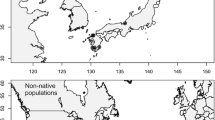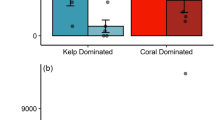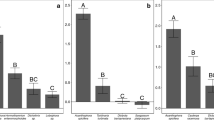Summary
Small, relatively sedentary herbivores like amphipods and polychaetes (mesograzers) often live on the plants they consume and should therefore view plants as both foods and living sites. Large, relatively mobile herbivores like fishes commonly move among, and feed from, many plants; they should view plants primarily as foods and rarely as potential living sites. In marine communities, fishes that consume plants are also important predators on mesograzers. Since seaweeds avoided by fishes should represent safer living sites for small herbivores, mesograzers living on and consuming seaweeds that are not eaten by fishes should have higher fitness than mesograzers living on plants preferred by fishes. In previous work, we demonstrated that seaweed secondary metabolites that deterred feeding by a fish and sea urchin had no effect on feeding by a common amphipod (Hay et al. 1987a). We then hypothesized that mesograzers would, in general, be less affected by seaweed chemical defenses than larger, more mobile herbivores like fishes. In this investigation, we evaluate the generality of this hypothesis by comparing the feeding of an omnivorous fish (Lagodon rhomboides) with that of an omnivorous, tube-building polychaete (Platynereis dumerilii) to see if the mesograzer prefers seaweeds avoided by the fish and if it is less affected by seaweed chemical defense. Platynereis dumerilii fed almost exclusively on Dictyota dichotoma, the seaweed eaten least by Lagodon rhomboides. The diterpene alcohols (dictyol-E and pachydictyol-A) produced by Dictyota significantly deterred feeding by Lagodon but did not affect, or at one concentration stimulated, feeding by Platynereis. Our data support the hypothesis that small, relatively sedentary herbivores that live on plants are more resistant to chemical defenses than are large, relatively mobile herbivores that move among many plants.
Similar content being viewed by others
References
Adams SM (1976) Feeding ecology of eelgrass fish communities. Trans Amer Fish Soc 105:514–519
Bousfield EL (1973) Shallow-water Gammaridean Amphipoda of New England. Correll University Press, Ithaca, NY
Brattsten LB (1979) Biochemical defense mechanisms in herbivores against plant allelochemicals. In: Rosenthal GA, Janzen DH (eds) Herbivores: Their Interaction with Secondary Plant Mctabolites, Academic Press, NY, pp 200–270
Brawley SH, Adey WH (1981a) The effect of micrograzers on algal community structure in a coral reef microcosm. Mar Biol 61:167–177
Brawley SH, Adey WH (1981b) Micrograzers may affect macroalgal density. Nature 292:177
Brostoff WN (1985) Seaweed grazing and attachment by the nereid polychaete Platynereis dumerilii. Proc 5th Int Coral Reef Congr Tahiti 4:3–8
Carpenter RC (1986) Partitioning herbivory and its effects on coral reef algal communities. Ecol Monogr 56:345–363
Darcy GH (1985a) Synopsis of biological data on the spottail pinfish, Diplodus holbrooki (Pisces: Sparidae) NOAA Technical Report National Marine Fisheries Serive No. 19, US Department of Commerce
Darcy GH (1985b) Synopsis of biological data on the pinfish, Lagodon rhomboides (Pisces: Sparidae). NOAA Technical Report National Marine Fisheries Service No. 23, US Department of Commerce
Dauterman WC, Hodgson E (1978) Detoxication mechanisms in insects. In: Rockstein M (ed), Biochemistry of Insects. Academic Press, NY, pp 541–577
Day JH (1973) New Polychaeta from Beaufort, with a key to all species recorded from North Carolina. NOAA Technical Report National Marine Fisheries Service Circ. 375, US Department of Commerce
Edgar GJ (1983) The ecology of south-east Tasmanian phytal animal communities. IV. Factors affecting the distribution of ampithoid amphipods among algae. J Exp Mar Biol Ecol 70:205–225
Fauchald K, Jumars PA (1979) The diet of worms: a study of polychaete feeding guilds. Oceanogr Mar Biol Ann Rev 17:193–284
Fox LR, Morrow PA (1981) Specialization: species property or local phenomenon? Science 211:887–893
Futuyma DJ (1983) Evolutionary interactions among herbivorous insects and plants. In: Futuyma DJ, Slatkin M (eds) Coevolution, Sinauer Associates Inc, Sunderland, MA, pp 207–231
Gaines SD, Lubcheno J (1982) A unified approach to marine plant-herbivore interactions. II. Biogeography. Ann Rev Ecol Syst 13:111–138
Geiselmann JA, McConnell OJ (1981) Polyphenols in brown algae Fucus vesiculosus and Ascophyllum nodosum: chemical defense against the marine herbivorous snail, Littorina littorea. J Chem Ecol 7:1115–1133
hawkins SJ, Hartnoll RG (1983) Grazing of intertidal algae by marine invertebrates. Oceanogr Mar Biol Ann Rev 21:195–282
Hay ME (1984) Predictable spatial escapes from herbivory: how do these affect the evolution of herbivore resistance in tropical marine communities? Oecologia (Berlin) 64:396–407
Hay ME (1985) Spatial patterns of herbivore impact and their importance in maintaining algal species richness. Proc 5th Int Coral Reef Congr Tahiti. 4:29–34
Hay ME (1986) Associational plant defenses and the maintenance of species diversity: turning competitors into accomplices. Am Nat 128:617–641
Hay ME, Duffy JE, Pfister CA, Fenical W (1987a) Chemical defense against different marine herbivores: are amphipods insect equivalents? Ecology 68:1567–1580
Hay ME, Fenical W, Gustafson K (1987b) Chemical defense against diverse coral-reef herbivores. Ecology 68:1581–1591
Hay ME, Paul VJ, Lewis SM, Gustafson K, Tucker J, Trindell R (1988) Can tropical seaweeds reduce herbivory by growing at night?: diel patterns of growth, nitrogen content, herbivory, and chemical versus morphological defenses. Oecologia (Berlin) 75:233–245
Lawrence JM (1975) On the relationship between marine plants and sea urchins. Oceanogr Mar Biol Ann Rev 13:213–286
Lewis SM (1986) The role of herbivorous fishes in the organization of a Caribbean reef community. Ecol Monogr 56:183–200
Lobel PS, Ogden JC (1981) Foraging by the herbivorous parottfish Sparisoma radians. Mar Biol 64:173–183
Lubchenco J, Gaines SD (1981) A unified approach to marine plant-herbivore interactions. I. populations and communities. Ann Rev Ecol Sys 12:405–437
McConnell OJ, Hughes PA, Targett NM, Daley J (1982) Effects of secondary metabolites on feeding by the sea urchin, Lytechinus variegatus. J Chem Ecol 8:1427–1453
Nelson WG (1979a) Experimental studies of selective predation on amphipods: Consequences for amphipod distribution and abundance. J Exp Mar Biol Ecol 38:225–245
Nelson WG (1979b) An analysis of structural pattern in an eelgrass (Zostera marina L.) amphipod community. J Exp Mar Biol Ecol 39:231–264
Nelson WG (1980) A comparative study of amphipods in seagrasses from Florida to Nova Scotia. Bull Mar Sci 30:80–89
Nelson WG (1981) Experimental studies of decapod and fish predation on seagrass macrobenthos. Mar Ecol Prog Ser 5:141–149
Nicotri ME (1977) The impact of crustacean herbivores on cultured seaweed populations. Aquaculture 12:127–136
Nicotri ME (1980) Factors involved in herbivore food preference. J Exp Mar Biol Ecol 42:13–26
Ogden JC (1976) Some aspects of herbivore-plant relationship on Caribbean reefs and seagrass beds. Aquatic Botany 2:103–116
Paul VJ, Hay ME, Duffy JE, Fenical W, Gustafson K (1988) Chemical defense in the seaweed Ochtodes secundiramea (Rhodophyta): effects against diverse coral-reef herbivores. J Exp Mar Biol Ecol (in press)
Paul VJ, Van Alstyne K (1988) Chemical defense and chemical variation in the genus Halimeda. Coral Reefs (in press)
Robertson AI, Lucas JS (1983) Food choice, feeding rates, and the turnover of macrophyte biomass by a surf-zone inhabiting amphipod. J Exp Mar Biol Ecol 72:99–124
Steinberg PD (1985) Feeding preferences of Tegula funebralis and chemical defenses of marine brown algae. Ecol Monogr 55:333–349
Steneck RS (1983) Escalating herbivory and resulting adaptive trends in calcareous algal crusts. Paleobiology 9:44–61
Steneck RS (1986) The ecology of coralline algal crusts: convergent patterns and adaptive strategies. Ann Rev Ecol Syst 17:273–303
Steneck RS, Watling L (1982) Feeding capabilities and limitation of herbivorous molluscs: a functional group approach. Mar Biol 68:299–319
Stoner AN (1980) Abundance, reproductive seasonality and habitat preferences of amphipod crustaceans in seagrass meadows of Apalachee Bay, Florida. Contrib Mar Sci 23:63–77
Targett NM, Targett TE, Vrolijk NH, Ogden JC (1986) The effect of macrophyte secondary metabolites or feeding preferences of the herbivorous parrotfish Sparisma radians. Mar Biol 92:141–148
Taylor WR (1960) Marine algae of the eastern tropical and subtropical coasts of the Americas. University of Michigan Press, Ann Arbor, MI
Vadas RL (1977) Preferential feeding: an optimization strategy in sea urchins. Ecol Monogr 47:337–371
Young DK, Buzas MA, Young MN (1976) Species densities of macrobenthos associated with seagrass: A field experimental study of predation. J Mar Res 34:577–592
Young DK, Young MW (1978) Regulation of species densities of seagrass-associated macrobenthos: Evidence from field experiments in the Indian River estuary, Florida. J Mar Res 36:569–593
Zimmerman R, Gibson R, Harrington J (1979) Herbivory and detrivory among gammaridean amphipods from a Florida seagrass community. Mar Biol 54:41–47
Author information
Authors and Affiliations
Rights and permissions
About this article
Cite this article
Hay, M.E., Renaud, P.E. & Fenical, W. Large mobile versus small sedentary herbivores and their resistance to seaweed chemical defenses. Oecologia 75, 246–252 (1988). https://doi.org/10.1007/BF00378605
Received:
Issue Date:
DOI: https://doi.org/10.1007/BF00378605




